Table of Contents
The Asset Browser is a panel included in the BigWorld tools World Editor, Model Editor, and Particle Editor, that manages game assets in a uniform and effective way.
It can be customised via its configuration file ual_config.xml (for details, see Customisation) to attend to your particular needs.
The Asset Browser displays the various categories of assets available for each tool (e.g., models, shells, textures, etc...) in a tree structure, with the asset type being the topmost level, and the subsequent levels being composed of the folders containing assets of that type. It also allows you to search assets by their name — metacharacters can be used.
Similarly to web browsers, the tools also allow you to store your most-used assets (in the Favourites virtual folder), apart from automatically storing the most recently used assets (in the History virtual folder).
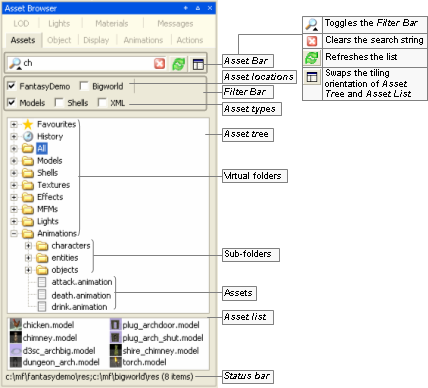
Asset Browser
The list below describes the fields on this panel:
-
Asset bar
-

Specifies the search string (with DOS-style wildcards) to dynamically apply to the Asset List.
The up/down arrow next to the magnifying glass expands/collapses the Filter Bar. A black arrow indicates that at least one filter criteria is checked in the Filter Bar, and a grey one indicates that none is checked.
-
 A
AClears the search string.
-
 A
ARefreshes the Asset List.
-
 A
ASwaps between horizontal and vertical tiling of the Asset Tree and the Asset List.
-
-
Filter bar
-
Asset locations
Restricts the location of assets to be displayed in the Asset List.
If no location is selected, then all folders in the resources folders list (or
<res>) will be searched.CIf at least one location is selected, then only those ones that are selected and are listed in the resources folders list will be searched. The list of locations is tool-specific, and can be configured.B
-
Asset types
Restricts the type of assets to be displayed in the Asset List.
The list of types is tool-specific, and can be configured.B
-
-
Asset tree
Set of virtual folders, in a tree-style view, giving access to the assets.
-
Virtual folders
Unless changed by the user, the list of virtual folders will always start with the nodes Favourites, History, and All. The remaining nodes are tool-specific, and can be configured either in the ual.config.xml configuration fileB, or via drag-and-dropD.
Virtual folders also have context menus. For details, see Virtual folder.
-
Asset list
List of assets resulting from the following combination:
-
Search string (specified in the Asset Bar).
-
Selected filters (specified in the Filter Bar).
-
Current virtual folder (specified in the Asset Tree).
Drag-and-drop from the list is supported, and is tool-specific. For details, see:
-
World Editor's implementation in Drag-and-drop
-
Model Editor's implementation in Drag-and-drop
-
Particle Editor's implementation in Drag-and-drop
-
-
Status bar
Displays information about the current item in the Asset Tree (virtual folder, or virtual folder's sub-folder), or in the Asset List (asset file).
For details, see Status bar information.
A — The appearance and inclusion of these buttons is tool-specific, and can be configured. For details, see Customisation.
B — For details, see Customisation.
C — For details on how BigWorld compiles this list, see Starting the Tools.
D — For details, see Drag-and-drop.
The status bar displays information about the item selected in the Asset Tree or in the Asset List, as described in the list below:
-
Virtual folder —
<result_folders>(<number_of_found_files>items)<result_folders>is the list of folders in the search path for which at least one asset was actually found.Example 7.1. Example
Assuming the following:
-
Search path contains the folders below:
-
C:\mf\gamebkp\res\avatars
-
C:\mf\gamebkp\res\npc
-
C:\mf\gamedev\res\avatars
-
C:\mf\gamedev\res\npc
-
-
Only the following folders contain at least one file with the extension configured for the selected virtual folder:
-
gamebkp/res/avatars (2 files with the relevant extension)
-
gamecli/res/avatars (2 files with relevant extension)
-
gamedev/res/npc (1 files with the relevant extension)
-
gametest/res/avatars (1 files with the relevant extension)
-
-
<result_folders>would then contain the following folders:-
gamebkp/res/avatars
-
gamedev/res/npc
-
The status bar would then display the following:
-
C:\mf\gamebkp\res\avatars;C:\mf\gamedev\res\npc (3 items)
The diagram below illustrates how this is established.
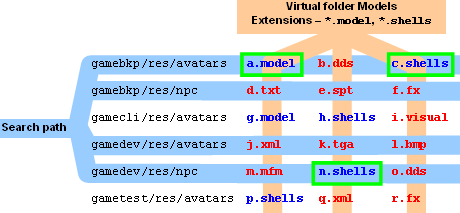
-
-
Sub-folder —
<source_folders>(<number_of_found_files>items)<source_folders> is the list of paths containing the folder which assets are displayed in the Asset List.
Note that all folders in the list will be displayed, regardless of them containing assets or not.
Example 7.2. Example
Assuming the following:
-
The search path contains the folders below:
-
C:\mf\gamedev\res\npc
-
C:\mf\gametst\res\npc
-
C:\mf\gamebkp\res\npc
-
-
The file system contains the folders below:
-
C:\mf\gamedev\res\npc
-
C:\mf\gamebkp\res\npc
-
The status bar would then display the following:
-
C:\mf\gamedev\res\npc;C:\mf\gamebkp\res\npc (
<n>items)
-
-
Asset file —
<absolute_path><filename>
Context menus are accessed by right-clicking a screen element.
The list below describes the menu items available in the virtual folder's context menu:
-
List view styles
-
List, Small icons, Big icons
Swaps the display style in the Asset List.
-
-
Change this panel's title
Opens the Change Asset Browser Panel Title dialog box, where you can specify new full window and short titles for the Asset Browser panel.
The Full Window Title is used as the panel's title, and the Short Title as the tab's title.
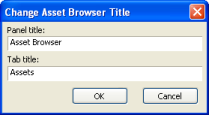
Change Asset Browser Title dialog box
-
Reload default folders
Reloads all virtual folders specified in the configuration file , in their original order.
-
Remove '
<name>'Removes the current virtual folder.
-
Clear contentsA
Clears the items in the list of the selected virtual folder.
A — Only available for Favourites and History virtual folders.
The list below describes the menu items available in the sub-folder's context menu:
-
List view styles
-
List, Small icons, Big icons
Swaps the display style in the Asset List.
-
-
Open folder in ExplorerA
Opens a new Windows Explorer window, displaying the contents of the selected sub-folder.
-
Copy path to clipboardA
Copies the sub-folder's absolute path to the clipboard.
A — If the sub-folder is available in more than one folder in the search path, then one menu item will be created for each of them.
The list below describes the menu items available in the asset list's context menu:
-
List view styles
-
List, Small icons, Big icons
Swaps the display style in Asset List.
-
The list below describes the menu items available in the asset's context menu:
-
List view styles
-
List, Small icons, Big icons
Swaps the display style in Asset List.
-
-
Add to favourites
Adds the selected model to the special virtual folder Favourites.
-
Open folder in ExplorerA
Opens a new Windows Explorer window, displaying the contents of the selected sub-folder.
-
Copy path to clipboardA
Copies the sub-folder's absolute path to the clipboard.
-
Edit in Model EditorC
Opens the selected item in Model Editor.
-
Edit in Particle EditorC
Opens the selected item in Particle Editor.
-
Open modelB
Opens the selected model in the viewport.
-
Add modelB
Performs the same functions as Model Editor's File → Add Model menu item. For details, see Menu items.
A — If the sub-folder is available in more than one folder in the search path, then one menu item will be created for each of them.
B — Available only in Model Editor.
C — Available only in World Editor
Items in the Asset Tree and Asset List provide drag-and-drop features, as described in the following sections.
The effect of virtual folder's drop action depends on where it occurs:
-
On Asset Tree
Virtual folder's position in the tree is changed to where it was dropped.
-
On Asset Tree of another Asset Browser panel
Virtual folder is copied to the other Asset Browser panel's Asset Tree.
-
Anywhere else
An Asset Browser panel is created, containing the Asset Bar, Filter Bar, Asset Tree (having only the dragged virtual folder), and Asset List. Note that the new panel allows drag-and-drop like any other panel (for details, see Drag-and-drop).
The effect of sub-folder's drop action depends on where it occurs:
-
On Asset Tree
A new virtual folder is created, with contents of the dragged sub-folder.
-
On Asset Tree of another Asset Browser panel
Sub-folder is copied to the other Asset Browser panel's Asset Tree.
-
Anywhere else
An Asset Browser panel is created, containing the Asset Bar, Filter Bar, Asset Tree (having only the dragged sub-folder), and Asset List. Note that the new panel allows drag-and-drop like any other panel (for details, see Drag-and-drop).
The effect of asset file's drop action depends on where it occurs:
-
On Asset Tree's Favourites virtual folder
File is copied to the virtual folder.
-
On application's viewport
Tool-specific behaviour.
For details, see:
-
World Editor's implementation in Drag-and-drop
-
Model Editor's implementation in Drag-and-drop
-
Particle Editor's implementation in Drag-and-drop
-
-
Anywhere else
Disabled.
Various elements of the Asset Browser can be customised, with each tool having its own configuration.
The configuration is saved on the tool's resources/ual folder, in the ual_config.xml file. For details on this file's grammar, see the document File Grammar Guide's section ual_config.xml.
The illustration below shows which elements can be configured, and how.
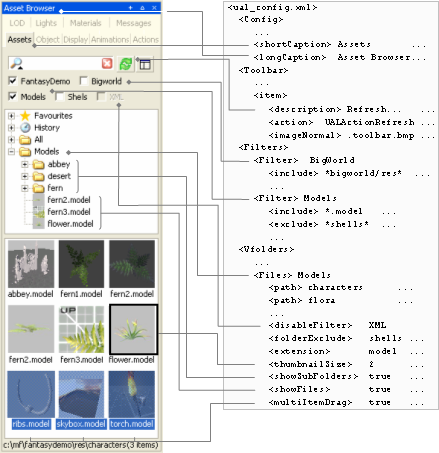
Example of Asset Browser customisation
The files displayed in the Asset List are determined by the list of search paths, the locations selected in Asset Locations, and the types selected in Asset Types.
Each node in the Asset Tree (with the exception of Favourites, History, and All) has a list of sub-folders to include in the search (specified in the configuration file (for details, see Customisation).
Each of these folders is then prefixed by all folders in the search path, which is specified according to the rule below:
-
If no check box is selected in Asset Locations:
The search path will contain all folders in the resources folders list (or
<res>) — for details on how BigWorld compiles this list, see Starting the Tools. -
If at least one location is selected
The search path will contain only the resource folders that are selected and are listed in the resources folders list.
Example 7.3. Example
Assuming the following:
-
The characters virtual folder is configured to search the following folders:
-
avatars
-
npc
-
-
The configuration file specifies the following Asset Locations:
-
Base assets — *base/res*
-
Level 1 (novice missions) — *level1/res*
-
Level 2 (expert missions) — *level2/res/*
-
Level 3 (final chapter) — *level3/res/*
-
-
Asset Locations has the following check boxes selected:
-
Base Assets
-
Level 1
-
Level 2
-
-
Resources folders list is set to:
-
C:\mf\level1\res;C:\mf\level2\res;C:\mf\level3\res
-
To determine
<search_path>:-
Make a list of all folders that are present in the resources folders list and are selected in Asset Locations:
-
In our example: C:\mf\level1\res;C:\mf\level2\res
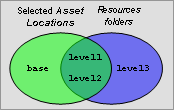
-
-
Use the list to prefix all search folders specified for selected virtual folder. The folder in the resulting
<search_path>will be:-
C:\mf\level1\res\avatars -
C:\mf\level1\res\npc -
C:\mf\level2\res\avatars -
C:\mf\level2\res\npc
-
-
